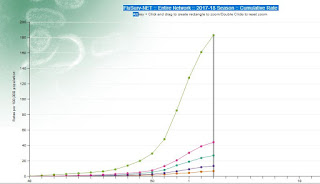
#13,102
Dashing hopes that we might have already seen the peak in this year's flu season, this week's FluView numbers show a still growing winter epidemic, with ILI visits to doctors last week exceeding anything we've seen since the height of the 2009 H1N1 pandemic.
Overall (all ages) hospitalization rates have jumped over the last week from 31.5 laboratory-confirmed influenza-associated hospitalizations per 100,000 population to 41.9, with those over 65 being hardest hit (180+).
P&I mortality - which is often a lagging indicator, and whose numbers reflect deaths for the week ending January 6, 2018 (week 1) - continues to climb, rising from 8.2% in last week's FluView report to 9.1% this week.
While not quite at the levels seen during the 2013 and 2015 winter flu seasons - given the delays in reporting and the current trajectory - we could see those numbers tested in the next couple of weeks.
Although H3N2 still dominates the fluscape across the United States, we continue to see both H1N1 and Influenza B creeping up in the stats (see chart below) raising the possibility of seeing a second strain take hold later in the spring.
Some additional highlights of this weeks report include:
Weekly U.S. Influenza Surveillance Report
2017-2018 Influenza Season Week 3 ending January 20, 2018
All data are preliminary and may change as more reports are received.
Synopsis:
During week 3 (January 14-20, 2018), influenza activity increased in the United States.
(Continue .. . . )
Viral Surveillance: The most frequently identified influenza virus subtype reported by public health laboratories during week 3 was influenza A(H3). The percentage of respiratory specimens testing positive for influenza in clinical laboratories slightly increased.
Pneumonia and Influenza Mortality: The proportion of deaths attributed to pneumonia and influenza (P&I) was above the system-specific epidemic threshold in the National Center for Health Statistics (NCHS) Mortality Surveillance System.
Influenza-associated Pediatric Deaths: Seven influenza-associated pediatric deaths were reported.
Influenza-associated Hospitalizations: A cumulative rate of 41.9 laboratory-confirmed influenza-associated hospitalizations per 100,000 population was reported.
Outpatient Illness Surveillance:The proportion of outpatient visits for influenza-like illness (ILI) was 6.6%, which is above the national baseline of 2.2%. All 10 regions reported ILI at or above region-specific baseline levels. New York City, Puerto Rico, and 39 states experienced high ILI activity; the District of Columbia and five states experienced moderate ILI activity; three states experienced low ILI activity; and three states experienced minimal ILI activity.
Geographic Spread of Influenza:The geographic spread of influenza in Puerto Rico and 49 states was reported as widespread; Guam reported regional activity; the District of Columbia and one state reported local activity; and the U.S. Virgin Islands reported sporadic activity.
With potentially 6 to 10 weeks left of influenza, it isn't too late to get a flu shot. And whether you've had the jab or not, always practice good flu hygiene (wash hands, cover coughs, and STAY HOME IF YOU ARE SICK).




